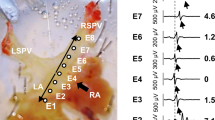Summary
The cardiac and coronary vasodilator effects of MDL 17043 and MDL 19205 were compared in isolated, blood-perfused papillary muscle, sinoatrial (SA) node, and atrioventricular (AV) node preparations of dogs. In these preparations, MDL 17043 (0.01–3 µmol) and MDL 19205 (0.01–3 µmol) were injected intra-arterially. Both drugs increased the force of contraction of papillary muscles paced at a rate of 120 stimuli/min, and a ten-fold increase in dose produced about a 100% increase in the force. The two drugs increased the sinus rate in SA node preparations, and a tenfold increase in dose resulted in about a 12% increase in sinus rate with MDL 17043 and about a 17% increase with MDL 19205. These drugs increased the rate of automaticity of spontaneously beating papillary muscles and also the force of contraction. With a ten-fold increase in dose, the increase in the rate was about 16% for MDL 17043 and about 9% for MDL 19205. No ventricular arrhythmias were produced by either drug. The drugs equally decreased AV conduction time by accelerating AV nodal conduction in AV node preparations whose right atria were paced at a rate of 150 stimuli/min. However, the decrease remained about 5% with a ten-fold increase in dose of both drugs. No AV junctional tachycardia was produced. In all preparations, both drugs increased (coronary) blood flow. In paced papillary muscle preparations a tenfold increase in dose resulted in about a 37% increase in blood flow with MDL 17043 and about a 42% increase with MDL 19205. Thus, it can be concluded that both drugs possess an almost identical profile in cardiac and coronary vasodilator effects. If there is any difference between the two drugs, it may be in pharmacokinetics but not in pharmacodynamics.
Similar content being viewed by others
References
Dage RC, Roebel LE, Hsieh CP, Weiner DL, Woodward JK (1982) Cardiovascular properties of a new cardiotonic agent: MDL 17,043 (1,3-dihydro-4-methyl-5-[4-(methylthio)-benzoyl]-2H-imidazol-2-one). J Cardiovasc Pharmacol 4: 500–508
Roebel LE, Dage RC, Cheng HC, Woodward JK (1982) Characterization of the cardiovascular activities of a new cardiotonic agent, MDL 17043 (1,3-dihydro-4-methyl-5-[4-(methylthio)-benzoyl]-2H-imidazol-2-one). J Cardiovasc Pharmacol 4: 721–729
Kariya T, Wille LJ, Dage RC (1982) Biochemical studies on the mechanism of cardiotonic activity of MDL 17,043. J Cardiovasc Pharmacol 4: 509–514
Endoh M, Yanagisawa T, Morita T, Taira N (1985) Differential effects of sulmazole (AR-L 115 BS) on contractile force and cyclic AMP levels in canine ventricular muscle: Comparison with MDL 17,043. J Pharmacol Exp Ther 234: 267–273
Taira N (1984) New positive inotropic agents: Their modes and mechanism of action. In: Abe H, Ito Y, Tada M, Opie LH (eds) Regulation of cardiac function. Japan Scientific Societies Press, Tokyo, pp 293–303
Dage RC, Roebel LE, Hsieh CP, Woodward JK (1984) Cardiovascular properties of a new cardiotonic agent, MDL 19205. J Cardiovasc Pharmacol 6: 35–42
Roebel LE, Dage RC, Cheng HC, Woodward JK (1984)In vitro andin vivo assessment of the cardiovascular effects of the cardiotonic drug MDL 19205. J Cardiovasc Pharmacol 6: 43–49
Kariya T, Wille LJ, Dage RC (1984) Studies on the mechanism of the cardiotonic activity of MDL 19205: Effects on several biochemical systems. J Cardiovasc Pharmacol 6: 50–55
Endoh M, Hashimoto K (1970) Pharmacologic evidence of autonomic nerve activities in canine papillary muscle. Am J Physiol 218: 1459–1463
Kubota K, Hashimoto K (1973) Selective stimulation of the parasympathetic preganglionic nerve fibres in the excised and blood-perfused SA node preparation of the dog. Naunyn Schmiedebergs Arch Pharmacol 278: 135–150
Hashimoto K, Iijima T, Hashimoto K, Taira N (1972) The isolated and cross-circulated AV node preparation of the dog. Tohoku J Exp Med 107: 263–275
Endoh M, Kimura T, Hashimoto K (1974) Effect of manganese ions on the contraction and automaticity of the blood-perfused canine papillary muscle. Jpn J Pharmacol 24: 771–778
Roebel LE, Hodgeman RJ, Velayo NL, Dage RC, Woodward JK (1983) Effect of MDL 17043, a new cardiotonic agent, on myocardial oxygen consumption. J Pharm Pharmacol 35: 247–249
Author information
Authors and Affiliations
Rights and permissions
About this article
Cite this article
Wada, Y., Taira, N. Comparative study of MDL 17043 and MDL 19205, new positive inotropic agents, by use of isolated, blood-perfused dog-heart preparations. Heart Vessels 2, 29–35 (1986). https://doi.org/10.1007/BF02060241
Issue Date:
DOI: https://doi.org/10.1007/BF02060241




